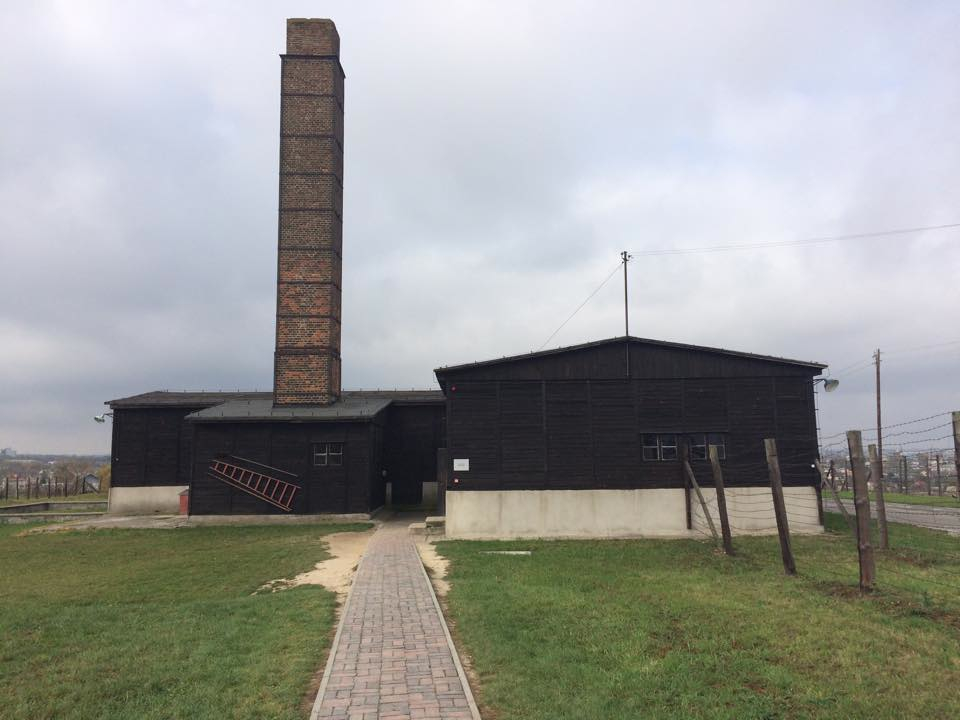I Went to a Nazi Concentration Camp on Saturday
I really didn’t want to visit Majdanek, a former Nazi concentration camp in Lublin, Poland. Like most people, I found Schindler’s List pretty difficult to watch; I couldn’t finish my tour of the Holocaust Memorial in Washington D.C. And so, when I wound up in Poland for a very short visit with my band this past weekend, I was thinking more about beer and pierogi — not about confronting the worst evil that mankind has to offer.
“That is the bad part of our history,” a local bar owner told me late Thursday night, when I ticked off the list of possible sites I’d be visiting during my stay. “You should just have a good time, and tell people about that.” He clearly didn’t want me to visit the death camp, and he definitely didn’t want me telling people about it.
And that’s when I knew that I had to go to the Nazi death camp at Majdanek.
On Saturday morning, while most of the band was in bad shape from an all-nighter of Żubrówka bison-grass vodka and dancing, I set out on foot from my hotel in Lublin, a mid-sized Polish city about 100 miles southeast of Warsaw, the capital. I could have taken a trolleybus, but I needed the hourlong walk through the damp morning air to clear my head.
If not for the fact that my destination was a former Nazi concentration camp, I probably wouldn’t have noticed the storefront selling gaudy caskets along the way. And the rusty barbed wire completely surrounding one old home likely wouldn’t have earned more than a half-second of my attention. As beautiful as the “old town” portion of Lublin is with its cathedrals and 17th Century architecture, this particular stretch of road was downright ugly.
But then, gradually, a sprawling green field comes into view. It could be a rural farm. But it’s not. It is Majdanek.
The Majdanek concentration camp may not be as well known as Auschwitz, but it is actually the best-preserved of all of the Nazi camps. It was also the first camp to become a monument, having been established in November 1944, making this year its 70th anniversary.
People like to argue about how many people were killed at Majdanek. The figures range from 79,000 to 360,000, with most research agreeing that the vast majority of the victims were Jews. Whatever the figure, clearly many people’s lives ended at Majdanek in some of the most horrific ways possible. In one day alone, approximately 18,000 Jews were killed by firing squad at Majdanek, part of an operation known as “Harvest Festival.”
As I walked through the camp, one of my first stops was the men’s bathhouse with its sign that translates to “Bath and Disinfection.”
Throughout the entire property are plaques bearing testimonials from those who were imprisoned at Majdanek. Inside the bathhouse is this one from prisoner Andrzej Stanislawski:
They herded us out into the frost. From in front of the Effektenkammer we rushed naked and barefoot through the biting frost to a barracks with a sign reading “Bad” or bathhouse. They cut the remaining hair off our heads with dull clippers and pushed us into a filthy room covered with bright-blue wooden slats.
From the ceiling hung several dozen showerheads and there was a long table under the windows. Next to the door we had entered from that “waiting room” stood an enormous concrete tub full of water reeking of carbolic acid.
Suddenly icy water spluttered from the showers — people screamed that it was cold. A few seconds later, boiling liquid gushed from the showerheads in clouds of steam. We wanted to escape, but there was nowhere to go, and those huddling at the edges were chased under the boiling shower with sticks and whips.
A few seconds later came another stream of icy water — our shower was over. But they made us take an additional “bath,” this time in that concrete vat of carbolic acid. They referred to it ironically as a “disinfectant bath” and used their sticks to make sure no one avoided it.
I also visited the structure that once housed a gas chamber:
At Majdanek, the Nazis preferred to gas prisoners with Zyklon B, a German pesticide made with cyanide. According to a guide at Majdanek, prisoners were given hot showers before being gassed, because the Germans believed that the hotter the body, the quicker the death. Presumably, the Nazi captors weren’t concerned about a quick and painless experience but with the efficiency of the process and the conservation of their resources.
There is also a crematorium:
There’s an area that just looks like a bumpy field. But it is, in fact, a series of “execution ditches.” Those 18,000 people killed during the “Harvest Festival” were stacked and burned here.
The most moving area of Majdanek for me had to be a room that houses bins containing thousands upon thousands of shoes from the camp’s victims, who did nothing to deserve their cruel fate:
There is a similar display at the Holocaust Memorial in Washington D.C., and the shoes there are on loan from Majdanek. Apparently there were plenty to spare.
One of the final structures I encountered at Majdanek was this mausoleum, built after the camp was liberated. The mausoleum contains the ashes of some of the camp’s victims. Visitors place candles there.
On the mausoleum is an inscription, not visible here. The English translation:
Let Our Fate Be a Warning to You.
Follow @VictorFiorillo on Twitter.



